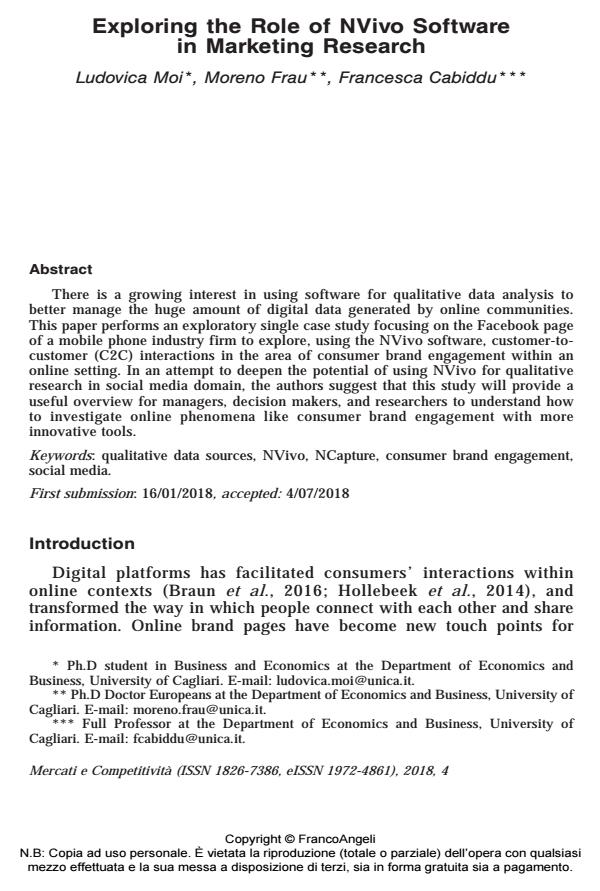Exploring the Role of NVivo Software in Marketing Research
Journal title MERCATI & COMPETITIVITÀ
Author/s Ludovica Moi, Moreno Frau, Francesca Cabiddu
Publishing Year 2018 Issue 2018/4
Language English Pages 22 P. 65-86 File size 512 KB
DOI 10.3280/MC2018-004005
DOI is like a bar code for intellectual property: to have more infomation
click here
Below, you can see the article first page
If you want to buy this article in PDF format, you can do it, following the instructions to buy download credits

FrancoAngeli is member of Publishers International Linking Association, Inc (PILA), a not-for-profit association which run the CrossRef service enabling links to and from online scholarly content.
There is a growing interest in using software for qualitative data analysis to better manage the huge amount of digital data generated by online communities. This paper performs an exploratory single case study focusing on the Facebook page of a mobile phone industry firm to explore, using the NVivo software, customer-tocustomer (C2C) interactions in the area of consumer brand engagement within an online setting. In an attempt to deepen the potential of using NVivo for qualitative research in social media domain, the authors suggest that this study will provide a useful overview for managers, decision makers, and researchers to understand how to investigate online phenomena like consumer brand engagement with more innovative tools.
Keywords: Qualitative data sources, NVivo, NCapture, consumer brand engagement, social media.
- Leading digital transformation through an Agile Marketing Capability: the case of Spotahome Ludovica Moi, Francesca Cabiddu, in Journal of Management and Governance /2021 pp.1145
DOI: 10.1007/s10997-020-09534-w - Analisi dei fattori determinanti l'adozione dell'Intelligenza Artificiale in sanità Francesco De Domenico, Guido Noto, Carlo Vermiglio, in MECOSAN 128/2024 pp.135
DOI: 10.3280/mesa2023-128oa18595 - The Palgrave Handbook of Interactive Marketing Moreno Frau, Luca Frigau, Francesca Cabiddu, Francesco Mola, pp.987 (ISBN:978-3-031-14960-3)
- Seeding innovation: the role of internal and external digital data in agri-food product innovation Moreno Frau, Tamara Keszey, in British Food Journal /2024 pp.286
DOI: 10.1108/BFJ-08-2023-0687 - Crisis, Chaos and Organizations Ludovica Moi, Simone Serpi, Francesca Cabiddu, pp.281 (ISBN:978-1-64802-780-2)
- The Phoenix Effect – Rising from crisis through digital collaboration – How crisis affects social enterprises’ digitalization for value co-creation? Hikmat Mursalzade, in Vezetéstudomány / Budapest Management Review /2025 pp.14
DOI: 10.14267/VEZTUD.2025.07-08.02
Ludovica Moi, Moreno Frau, Francesca Cabiddu, Exploring the Role of NVivo Software in Marketing Research in "MERCATI & COMPETITIVITÀ" 4/2018, pp 65-86, DOI: 10.3280/MC2018-004005